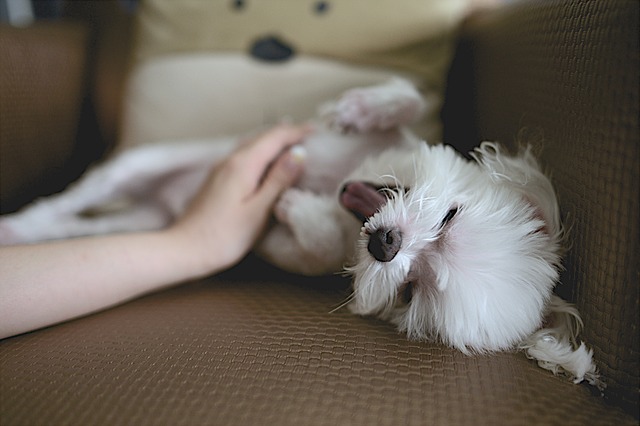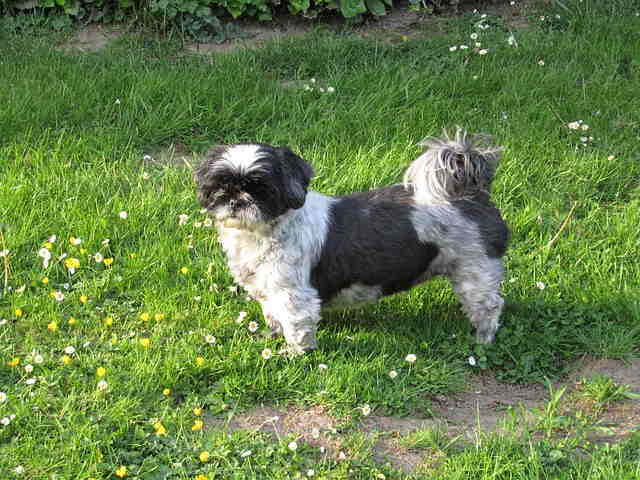- Home
- Shih Tzu Information
- dog talk
Unlock the Secret Language of Your Shih Tzu – How to Talk to Your Dog and Understand Their Responses
BY MOLLY | EVERYTHINGSHIHTZU.COM
Arf arf arf! Ruff ruff! Bark! Did you understand all that? Probably not, but your dog would if it could read.
Don’t worry, though. Since you can’t bark, it doesn’t mean it’s impossible to communicate with your dog.
 Observing and picking up cues is how to talk to your dog
Observing and picking up cues is how to talk to your dogIn truth, your dog’s favorite form of communication is through nonverbal cues and rewards. So, if you want to be able to talk to your dog, you should master these two systems.
And yes, your dog does love to bark and barking means something too, but we’ll look at that after the more essential forms of communication.
Here you'll learn:
How To Talk to Your Dog With Non-Verbal Cues
Learning nonverbal cues doesn’t mean you can’t speak to your dog. What it does mean is learning how to understand the nonverbal cues your dog uses with you.
For example, if your Shih Tzu wants to show he's relaxed around you or submissive, he will turn on his back and expose his belly.
 How To Talk Dog - Submissive
How To Talk Dog - SubmissiveOr, if he is uneasy about something, you may notice him pacing or cowering.
A dog’s eye contact is an important component of nonverbal communication.
Humans appreciate eye contact with one another, but dogs will actually avert their eyes from you as a sign of respect.
This does not mean every time your dog looks at you that he's being disrespectful. He may be trying to focus or be playful!
Pay attention to narrowed eyes or prolonged staring.
Narrowed eyes may suggest the dog is feeling aggressive. Prolonged staring can be a sign of dominance or a challenge.
You’ve probably seen your dog give this look whenever he's guarding a toy from you while playing with it!
My dog gives me a stare down every time we play with his rope toy.
His challenges are no more than playing, but he loves to look me in the eyes and prop his paws on his toy to let me know who he thinks is boss!
 What do you think Max is communicating with this look?
What do you think Max is communicating with this look?Another nonverbal cue is your dog’s tail.
Reading your dog’s tail is a key factor in how to speak dog.
This is more complex than the common assumption that a dog is happy if he is wagging his tail.
For example, a tail that is wagging in its natural position -- a teacup handle position in Shih Tzu -- shows they are happy or content. But, raised and stiff tail wags can be a sign of aggression.
Learning to understand the difference in these tail wags is important to understanding your dog.
How To Talk to Your Dog Using Rewards
I'm constantly in awe of the amazing relationship between pups and their humans - particularly when I see a well-behaved pup come to heel as soon as they're called or stay lying down no matter how tempting that squirrel hopping around the yard may be.
It almost feels like magic!
The reality is that these dogs understand exactly what is expected of them because their pet parent has unlocked the mystery of how to speak dog...Rewards!
When you reinforce desired behaviors with attention, affection and treats – whether that's rolling over for belly rubs or coming to heel on command – clear communication will be established between both human and canine companions.
 This little furbaby is loving his belly rub reward
This little furbaby is loving his belly rub rewardWhen it comes to my pup, there's no doubt that he is living his best life!
Whenever we want a couch cuddle session (which let’s be honest - happens ALL the time) all I need to do is call him up and before you can even blink, this furry dude’s already rolling on his back for his belly rub reward.
When training your dog or trying to communicate something you want from him, walk it through what you expect and apply the reward after.
A dog's memories are very effective at retaining rewards, so associating certain actions with a reward cultivates good behavior.
The opposite of rewarding good behavior is punishing poor behavior.
Unfortunately, many people think that punishing a dog for misbehavior is effective. Instead, this results in repeated mistakes and a stressful relationship for both dog and human.
Dogs’ memories do not process punishment well.
They can react in the moment and put on a look of guilt when they see you are mad about them tearing up the trash. But, when you are not around, they will go back to doing it again because they find it rewarding, whereas they will not recall anger or punishment.
In short, if a pet parent does not reinforce a dog’s system of reward, the dog is bound to -- as we would call it -- misbehave in looking for reward somehow else.
Understanding Barks as Part of How to Talk Dog
Dogs love barking. Sometimes, a bit too much!
Despite what we may sometimes feel, a dog does not bark for no reason. A dog will bark in reaction to something or if he is trying to tell you something he feels is important.
You should learn the difference between types of barks so you can understand what your dog wants. Keep the following examples in mind for unlocking the language of bark and mastering how to speak dog:
- A brief, high-pitched bark may be a sign of need. Dogs use a bark like this when they need you to let them outside to go potty or when they are thirsty and their water bowl is empty.
- Rapid, high-pitched barks are usually a sign of playfulness. If you are not in the same room as your dog and you hear this bark, you may want to get up and go join the fun!
- Low, gruff and gravely barks are a sign of aggression. This is what you hear when your dog perceives a threat, and you should investigate to see what is instigating your dog. Sometimes, it’s nothing more than a squirrel.
- Quick, mid-pitched barks are usually what you hear when you come home from work or school. This is the bark associated with excitement and joy. If you hear this, it means your dog is happy to see you!
- A high pitched yelp is a sign of pain or fear. When you hear a yelp, you should check on your dog because it may be hurt.
Learning to Communicate With Your Dog Requires Patience
Learning how to talk dog requires patience.
Associating commands with reward takes time, but your dog will learn. Understanding all of your dog’s nonverbal cues is a learning curve for owners but will lead to a more rich relationship with your dog.
We don’t call dogs man’s best friend for no reason.
With a little time and effort, you’ll find yourself talking dog with your best friend in no time!
- Home
- Shih Tzu Information
- dog talk



